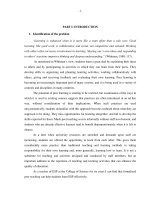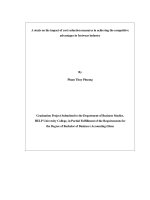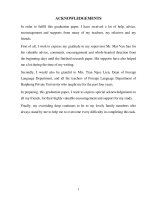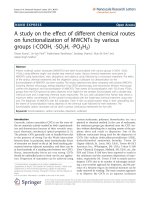A study on the use of neuber's rule in fatigue crack
Bạn đang xem bản rút gọn của tài liệu. Xem và tải ngay bản đầy đủ của tài liệu tại đây (6.27 MB, 164 trang )
A
Study
On
The
Use
Of
Neuber's
Rule
In
Fatigue
Crack
Initiation
Predictions
by
SANJEEV
K.
VISVANATIlA,
B.Eng.
A
thesis submitted
to
the Faculty
of
Graduate
Studies
and
Research
in
partial fulfillment
of
the requirements
for
the degree of
Master
of
Engineering
in
Aerospace Engineering
Department
of
Mechanical
and
Aerospace
Engineering
The Ottawa-Carleton Institute
for
Mechanicd
and
Aerospace
Engineering
Carleton Universis.
Ottawa,
Ontario,
Canada
September
1998
O
copyright
1998,
Sanjeev
K.
Visvanatha
National
Library
1*1
of
Canada
Bibliothkque
nationale
du
Canada
Acquisitions
and
Acquisitions
et
Bibliographie
Services
services bibliographiques
395
Wellington
Street
395,
nie
Wellington
Ottawa
ON
K1A
ON4
Ottawa
ON
KI
A
ON4
Canada
Canada
The
author
has
granted
a
non-
exclusive licence
allowing
the
National
Library
of Canada to
reproduce, loan, distribute or sell
copies of
this
thesis
in
microfom.,
paper or electronic
formats.
The
author
retains
ownership
of
the
copyright
in
this
thesis.
Neither
the
thesis
nor substantial
extracts
fiom
it
may be
printed
or
otherwise
reproduced without
the
author's
permission.
YOM
file
Votre
rëferenœ
Our
fi
Notre reférence
L'auteur a accordé
une
licence non
exclusive
permettant
à
la
Bibliothèque nationale
du
Canada
de
reproduire, prêter, distribuer
ou
vendre
des
copies de
cette
thèse
sous
la
forne
de
microfiche/^
de
reproduction
sur
papier ou sur format
électronique.
L'auteur
conserve
la
propriété
du
droit
d'auteur
qui
protège
cette
thèse.
Ni
la
thèse
ni
des
extraits
substantiels
de
celle-ci
ne doivent
être
imprimés
ou autrement reproduits
sans
son
autorisation.
Abstract
The local strain approach to fatigue life prediction contains
a
number of assumptions
which can lead to considerable error
in
the prediction of crack initiation Me. One
assumption is
the
use of
an
approximate relationship known
as
Neuber's
rule
to estirnate
the
stress
and
strain
at
the
notch root of
a
component.
The
applicability of Neuber's
rule
in
the local
strain
method
was
examined for two coupon geometrïes through
a
finite
element analysis.
Ln
addition, the ability of the local strain method to predict
the
lives of
the coupons subjected to spectm loading
was
assessed
by
comparing local strain
predictions for the two coupons
with
results fiom
a
coupon test program.
The
findings of
this
study
verified
the
applicability of Neuber's rule in
plane
stress situations.
A
method
of estimating multiaxial elastic-plastic
notch
stresses
and
strains
was
verified
to be
an
effective means of accounting for
notch
root multiaxiality.
A
method of estimating total
life,
composed of crack initiation and crack propagation, was proposed
which
accounts
for
the
notch size
effect
displayed
in
sharply notched coupons.
Acknowledgements
A
mentor
once
told
me that choosing a gnduate school is
sirnilar
to choosing
real
estate,
where
the
three most important criteria are "Location,
Location,
Location7'. He
went
on
to Say that it
was
the supervisor done who woufd either
"make
or break''
the
two-year
experience, leading
to
the parallel
mle
for graduate school: "Supervisor, Supervisor,
Supervisof'.
My
two supervisors, Professor
Paul
V.
Straznicky
and
Dr. Roy
L.
Hewitt,
confirmed this de and
were
instrumental
in
making
my
graduate degree
an
experience to
remember! Their sage advice inspired me to End?
and
in
many
cases, construct
the
roads
which led to here.
Several others were extremely helpful throughout
the
duration
of
this thesis. Thanks go
to
Mr.
Jan
Weiss for always
taking
the time
out
of his busy schedule
to
discuss the fmer
points of
C-CI89,
Ms. Pascale
AEe
for her assistance
in
the
expenmental program,
and
Mr. Luc Lafieur for coaching
me
on
the
use of
the
MTS
rig.
Sincere
gratitude
is expressed
to
The Natural Sciences
and
Engineering Research Council
(NSERC)
for
the
award
of
a
Post
Graduate Scholarship,
The
Canadian
Space
Agency
for
the
award
of
a
supplement
to
the
NSERC
scholarship, Carleton University
for
the
award
of
a
teaching
and
research
assistantship,
and
to
the
hstitute
for
Aerospace
Research
at
the
National
Research
Council
of
Canada
for
the
generous use
of
their facilities.
Thanks
go
to
my
fiiends for the stirnulating discussions
and
meaningless jokes which
helped
to
keep
uisanity
at
bay
through
the
years. Cheers!
Finaily, gratitude is expressed
to
my
parents,
my
siblings
and
their families. You
have
been
supportive
throughout
my academic career.
Thank
you.
Table
of
Contents
Absfract
III
Acknowledgements
m mms~m~m mmmmmm mmmm m.mm sm
mm.mmmm.miv
Table
of
Contents
.w~mm8mm.mms~.mm m.mm.œm8vi
List
of
Tables
xi
3.
List
of
Figures
mm~.m mmmm~m.mmmm.m.m.mœm m m~x~~
List
of
Appendices
.xv
Nomenclature
m.smm.wms.mmm.sm.mmLm.s~.smw.mmm m.mmw.
.xvi
Units
xx
Chapter
1
-
Introduction
mm~~mm.~mmI.mm.mmmmm.m.mmm ~mms.mam~m.m~.mmmm.mmm.mmmam.m.ml
Chapter
2
-
Review
of
Fatigue
Crack
Initiation Prediction
5
2-1
Introduction
,
5
.
.
2.2
Aspects
of
Fatigue
Crack
Initiation
5
2.3
Nominal
Stress
(NS)
Approach
6
2.4
Local
Strain
(LS)
Approach
8
2.4.1
Principle
of
LS
Method
8
2.4.2
LS
Method
9
2.5
Damage
Accumulation
1
6
2.6
Principle of Equivalence
18
2.6. 1
Concerns
,
18
2.6.2
Notch Stress-Strain Estimation
.,
19
2.6.3.1
Neuber'
s
Rule
and
irs
Variations
19
2.6.2.2
Equivalent Strain Energy Density
(ESED)
24
2.6.2.3
Finite Element
(FE)
halysis
,
25
2-63
Notch Severity
27
2.7
Fracture Mechanics
,.
29
2.8
S
urnrnary
30
Chapter
3
-
Project
Definition
mm.g
'.32
Chapter
4
-
Coupon
Test
Program
m.~~.
34
4.1 Introduction
34
4.2
Coupons
and
Test Sequences
34
4.3
Test Procedure
36
4.4
Detection of Crack Initiation
,.,
36
4.5
Test Results
, ,.,
37
4.6
Accuracy
of
Applied
Loads
38
4.7
Crack
Initiation
Sites
41
4.8
Summary
42
Chapter
5
-
Local Strain
Software
m m #.43
5.1 Introduction
,.
43
vii
5.2
Description of
C-CI89
43
5.3
McCracken
Fatigue
Life Prediction Program
44
5-3
-1
Material
Properties
Dialog Box
45
5.3.2
Spectrum
Dialog
Box
45
*
5.3.3 Prediction
Methods
Dialog Box
46
5.3.4 Executing the Prediction
47
5.3.5
Documenting Results
47
5.4
Validation
of
McCracken
47
5.4.1
Overview
of
Validation
47
5.4.2
Material Data
.,
,.
.
48
5.4.3
Cornparison of C-CI89
and
McCracken Predictions
48
5.5
Cornparison
of
Local
Strain
Prediction Programs 49
5.5.1
C-CI89
vs
.
LOOPIN8
49
5.5.2
CC189
vs
.
McCracken
50
5.6
Summary
52
Chapter
6
-
Finite
Element
Analysiç
m.mmm.m
m.mmmmmm53
6.1
Introduction
53
6.2 Constitutive Models
53
6.3 Loading
54
6.4
FEA of
Low
Kt
Coupon
55
6.4.1
Geometry
of
Low
Kt
FE
Mode1
55
6.4.2
Elastic
FEA
of
Low
Kt
Coupon
-
Verification
56
6-43
Elastic-Plastic
FEA
of Low
Kt
Coupon
57
6.5
FEA
of
High
Kt
Coupon
58
6.5.1 Geometry of High
K,
FE
Mode1
58
6.5.2
Elastic
FEA
of
High
Kt
Coupon
-
Verification
59
6.5.3
Elastic-Plastic
FEA
of
High
Kt
Coupon
60
6.6
Results
of
Elastic-f Iastic
FEA
60
6.6.1 Low
Kt
Coupon
61
6.6.2
High
Kt
Coupon
62
6.7 Discussion
of
FE
Results
62
6.8
Summary
64
Chapter
7
-
Sensitivity
Study
m.mmmmm~.m.Immœ m.m65
7.1
Objective
65
7.2
Description
of
the
Stress
and
Strah Estimation
Methods
66
7.2.1 Solution Technique for Neuber's Rule
66
7-22
Solution
Technique
for Glinka's
ESED
Method
67
7.2.3
Solution Technique for Ho&m
and
Seeger's Generalized
Meîhod
67
7.3
Sensitivity
of
Notch
Root
Stress and
Strain
.
69
7.3.1
Low
K,
Coupon
69
7.3
-2
High
Kt
Coupon
70
7.4
Sensitivity
of
Crack
Initiation
Predictions
71
7.4.1
Low
Kt
Coupon
71
7.4.2
High
K,
Coupon
72
7.5
Summary
*
73
Chapter
8
-
Discussion
of
Results
75
8.1 Introduction
75
8.2
Applicability
of
Neuber's
Rule
75
8.3
Agreement
between
LS
Predictions
and
Test Results
77
8.3.1
Introduction
77
8.3.2
Crack Initiation
vs
.
Total
Life
.,
78
8.3.3
Fatigue
Concentration
Factor
81
8.3.4
Estimating
Total
Life
83
8.4
Material
Properties
85
8.5
Equivalent
Strain
Equations
86
Chapter
9
-
Conclusions
88
9.1
Conclusions
88
9.2
Recomrnendations for
Future
Research
90
9.3
Summary
of
Contributions
91
References
m
32
List
of
Tables
Table
4-
1
:
Test
Results
for
Low
Kt
Coupons
37
Table
4-2:
Test
Results
for
High
Kt
Coupons
38
Table 5-1: Cornparison of
C-CI89
and
McCracken Predictions for tef-man35
48
Table
6-
1
:
Force Convergence for
Low
Kt
Coupon
58
Table 6-2: Force Convergence for High
Kt
Coupon
60
Table 7-1:
McCracken
Inputs
for
Crack initiation Sensitivity
Study
71
Table
8-1:
Indication of Crack Propagation
Phase
for
Low
Kt
Coupons
79
Table
8-2:
Crack
Length
at
First
Detection
for
Hi&
Kt
Coupons
80
Table
8-3:
Fatigue
Concentration Factors for Low
and
Hi&
Kt
Coupons
81
List
of
Figures
Figure
2-1:
Equivalence between Smooth
and
Notched
Specirnens
99
Figure 2-2: Local Stmin Method
-
Load
Spectnim
and
Cyclic
Stress-Strain
Curve
99
Figure
2-3:
Local Strain Method
-
Hysteresis Loop Tracking
100
Figure
2-4:
Volume
of
Critically
Stressed
Material
at
Blunt
and
Sharp
Notches
101
Figure
4-1:
Low
R
Coupon
Geometry
102
Figure
4-2:
High
Kt
Coupon
Geometry
103
Figure
4-3
:
Possible
Crack Initiation Sites
104
Figure
5-1:
McCracken Prediction Environment
105
Figure 5-2:
Materid
Properties Dialog Box
105
Figure
5-3
:
Spectrum Dialog Box
106
Figure
5-4:
Prediction Methods Dialog Box
106
Figure
5-5:
CycIic
Stress vs
.
StressWrain
Curve
-
AI
7050-T74
107
Figure
5-6:
Strain-Life Curve
-
Al-7050-T74
107
Figure
5-7: Cornparison
of
SWT
and
LOOPINS
Equivalent
Strain
Equaiions
108
Figure
5-8:
C-CI89
Representation of Stress vs
.
Stress*Strain Curve
108
Figure
6-
1
:
Aluminum
7050-T74 Stress-Strain
Curve
109
Figure
6-2:
Low
Kt
Coupon Mesh Convergence
Study
109
Figure
6-3:
Finite
Element
Geornetry
of
Low
Kt
Coupon
110
Figure
6-4:
Cornparison between
FE
results
and
approximate relationship for stress vs
.
distance
,.
.,,
110
Figure
6-5:
High
Kt
Coupon Mesh Convergence Study
111
Figure
6-6:
Finite
Element
Geometry of
High
K,
Coupon
111
Figure 6-7:
SP3
vs
.
Distance fiom Notch Root
-
Mid-Thickness of Low
Kt
Coupon
112
Figure
6-8: SP3
vs
.
Distance fiom Notch Root
-
Surface of Low
K,
Coupon
112
Figure 6-9:
EP3
vs
.
Distance f?om Notch Root
-
Mid-Thickness of Low
Kt
Coupon
113
Figure
6-10:
EP3
vs
.
Distance £?omNotch Root
-
Surface of Low
K,
Coupon
113
Figure 6-1 1: von Mises Stress vs
.
Distance
f70m
Notch Root
-
Mid-Thickness of Low
Kt
Coupon
114
Figure
6-12:
von Mises Stress vs
.
Distance fiom Notch Root
-
Surface of Low
Kt
Coupon
:
114
Fiame
6-13:
SP3
vs
.
Distance from Notch Root
-
Mid-Thickness
of
High
Kt
Coupon
.
115
Figure 6-14:
SP3
vs
.
Distance
fiom
Notch Root
-
Surface
of
High
Kt
Coupon
115
Figure 6-1
5:
EP3
vs
.
Distance frorn Notch Root
-
Mid-Thichess of
High
K,
Coupon
.
1
16
Figure 6-16:
EP3
vs
.
Distance
from
Notch Root
-
Surface
of
High
Kt
Coupon
116
Figure 6-1
7:
von Mises Stress
vs
.
Distance
fiom
Notch Root
-
Mid-Thickness of High
Kt
Coupon 117
Figure
6-18:
von Mises Stress vs
.
Distance fkom Notch Root
.
Surface of
High
Kt
Coupon
117
Figure
6-19:
Notch Root Stress vs
.
Net Section Nominal Stress
-
Low
Kt
Coupon
118
.
Figure
6-20:
Notch Root Strain vs Net Section Nominal Stress
-
Low
Kt
Coupon
118
Xlll
.
.
Figure
6-2
1
:
Notch Root Stress vs Net Section Nominal Stress
High
Kt
Coupon
1
19
.
.
Figure
6-22: Notch Root
Strain
vs
Net Section Nominal Stress High
Kt
Coupon
119
.
Figure
7-1
:
Low
Kt
Coupon
Stress
Estimation 120
.
Figure
7-2: Low
Kt
Coupon Strain Estimation 120
.
*
Figure
7-3:
Hi&
Kt
Coupon Stress Estimation 121
Figure
7-4:
High
Kt
Coupon
-
Strain
Estimation
121
Figure 7-5: Low
Kt
Coupon
.
Crack
Initiation Prediction Sensitivity
Study
122
Figure
7-6:
High
Kt
Coupon
-
Crack
Initiation
Prediction Sensitivity Study
122
.
Figure 8-1: Stress Intensiq Factor vs Crack
Length
123
Figure
8-2: Low
Kt
Coupon
-
Prestrain
and
Non-prestrain
LS
Predictions
123
Figure
8-3
:
Equivalent
Strain
Equation
Study
-
High
Kt
Coupon
124
xiv
List
of
Appendices
Appendix
A
O
Coupon
Test
Program
125
Appendix
B
=
Format
of
McCracken
hput
and
Results
Files
138
Nomenclature
Crack Initiation Life
Damage surn
Increment of damage
Design
Limit
Stress
Elastic moddus, Secant modulus
Principal strains,
ABAQUS
naming
system
Dimensioniess function of geometry (Equation
8-
1
)
Cyclic
hardening
coefficient (Equation
2-4)
Fatigue concentration factor
Theoretical stress concentration factor
Equivaient stress concentration factor (Equation
7-3)
Local
strain
concentration
Local stress concentration
Cycles to
failure
of smooth specimen
Nurnber
of
cycles to
failure
at
load
level
i
(Equation
2-1)
Number
of
load excursions
at
load
level
i
(Equation
2-1)
Test result for sequence
A
(Equation
2-2)
Improved
prediction for sequence
B
(Equation
2-2)
Predicted lives for sequences
A
and
B
(Equation
2-2)
S
train
ratio
Stress ratio
Net-section nominal stress
Principal stresses,
ABAQUS
naming system
Fatigue strength
Damage parameter (Equation 2-1
3)
Petersons's material constant (Equation
2-23)
Elastic stress ratios (Equations
7-1
and
7-2)
Fatigue strengtli exponent (Equation
2-9)
Fatigue ductility exponent (Equation 2-9)
Notch
depth
(Equation
8-1)
Net section nominal strain
Size
of crack
at
initiation (Equation
8-1)
Number
of
load
levek
(Equation 2-1)
Cyclic hardening exponent (Equation
2-4)
Notch radius
Coordinate directions
Principal
min
ratio
Principal plastic
strain
increment,
i
=
1,2,3
(Equation
2-1
9)
Equivalent plastic strain increment (Equation
2-
19)
Notch
root
strain
Fatigue ductility coefficient (Equation
2-9)
Principal strains
Principal plastic
strains,
i
=1,2,3
(Equation
2-20)
Equivalent plastic strains,
i =1,2,3
(Equation
3-20)
Poisson's ratio
and
modified Poisson's ratio (Equation
7-7)
Notch root stress
Principal elastic messes
Deviatoric stress, i
=
1,2,3
(Equation
2-19)
Fatigue strength coefficient (Equation
2-9)
Principal stresses
Hydrostatic stress tensor
Stress tensor
Deviatoric stress tensor
Prefixes:
A
range
Subscripts:
U
Y
eff
eq, q
ultimate
yield
effective
equivalent
xviii
ma
O
PL
Superscripts:
(notc hed)
(smooth)
maximum
or
peak
mean
plastic
notched
specimen
smooth
specimen
xix
Units
In keeping
with
the
practices of
the
North Amencan aerospace
industry
and
the hstitute
for Aerospace Research
(IAR)
at
the
National Research Council
of
Canada
(NRC),
the
British
Lmperiai
system
of units
is employed
in
this thesis.
Système
International
d'unités
(SI)
equivaients are
provided
in
brackets
within
the text
where
practicai.
The
following conversion factors are
useful:
1
inch
=
25.4
mm
1
lbf
=
4.4482
N
1
ksi
=
6.8948
MPa
1
kip
=
1000
lbf
Chapter
1
-
Introduction
Meta1 fatigue is a process which causes the failure of
an
engineering component subjected
to repeated loading. Typical engineering structures are cornplex,
and
are subjected to
irregular load histories. This? added
with
the cornpiex nature of
the
fatigue process,
makes it diEcuIt to accurately predict
the
life
of a structure. Nevertheless, fatigue
analysis methods
have
been developed over
the
years
to
aid
the
design engineer. Today,
fatigue life prediction is a fundamental undertaking in
the
design
of
many
cornponents
and structures used
in
the
automotive, aerospace
and
offshore industries.
Fatigue is
a
primary mode of failure for
aifiames.
In
general. fatigue cracks initiate
within the aifiame at points of stress concentration which
cm
occw due to
a
ïnaterial
flaw,
or
a
geometric feature such
as
a
cutout or a rivet hole.
Unless
detected
by
an
inspection prognm, these cracks may progress
through
the
stnicture until failure occurs.
Thus.
for convenience, the fatigue process is often divided into two phases: crack
initiation and crack propagation.
Fatigue life prediction methods
in
use today
are
based on
the
Nominal Stress
(NS),
Local
Strain
(LS).
and
Fracture Mechanics approaches. The
NS
approach uses constant
amplitude stress-life cwes to calculate
the
fatigue
damage based
on
the
nominal stress
in
the component.
A
total life (initiation
+
propagation) prediction results
fiom
the use
of
the
NS
approach. The
LS
approach differs fiom the
NS
approach in that
the
stress
and
strain state at the notch is considered. The
use
of
the
LS approach results
in
a
prediction
of
life to crack initiation. Finally, the fracture mechanics approach predicts the growth
of
a small crack
to
one which will cause failure of the component.
An
advantage to using
the
fracture mechanics approach is
that
damage is quantified
in
terms
of
a
visible
parameter> the crack length. This is in contrast to the
NS
and
LS
approaches where
damage is quantified in terms of a numerically calculated damage sum.
The
local
strain
approach is typically used
in
situations where life is defmed
as
the onset
of detectable flaws. One example is
in
the design of the
CF4
8
aircrafi.
The local straui
approach is also being used in analysis
work
for the International Follow-On Structural
Test Program (Simpson,
1997).
IFOSTP,
as
the project is known,
is
a
full
scale fatigue
test
of
the
CF48
airframe being conducted
by
the
Canadian Forces
(CF)
and
the Royal
Australian Air Force
(RAAF).
The
aft
fuselage
and
empennage tests are the
responsibility of
the
Australians. while the
wïng
and centre fuselage
are
Canada's
responsibility.
The centre fuselage test
is
currently underway at Bombardier
hc.,
Canadair Defense Systems Division
(BKDSD).
Preparations are being made for the
wing test at
the
Structures, Materials
and
Propulsion Laboratory of the lnstitute for
Aerospace Research
(SMPL-IAR)
at The National Research Council
of
Canada
(NRC).
The
full scale test is performed
by
agplying
a
representative load
history
to the test article
through
a
system of hydraulic acniators. IFOSTP
has
adopted
a
load spec-, derived
fiom flight test data which represents
279
flights of combined
CF
and
RAAF
usage.
To reduce
the
testing tirne, a process known
as
tnincation
is
adopted whereby small load
cycles
which
do not contribute to fatigue
darnage
are removed fiom the load spectrum
applied to the test article.
The
SMPL-IAR
is currently performing spectnim -cation
sensitivity studies to determine the level of truncation to apply to the
wing
load spectnim.
A
local
strain
based cornputer program,
C-CI89
(Klohr,
1990),
has
been adopted by
IFOSTP for use
in
the
spectrum tnincation sensitivity tests being conducted at
SMPL-
IAR.
Variants of the
-189
progam were used
in
the design of
the
CF-18,
and
are
currently used
by
the
CF
for fleet management purposes.
The
locai
strain
method contains
a
nurnber of assumptions which can cause considerable
error
in
predictions.
One
assurnption is the use of Neuber's mle to estimate the stress
and
strain
at the notch root of a component. Neuber's rule
was
derived for a specific
geometry and loading, but is generally used unconditionally
in
the
LS
method. The
objective of this thesis is to anaiyze the applicability of Neuber's rule
in
the local strain
approach.
The
layout of the thesis is
as
follows. Chapter 2 contains
a
review
of
research regarding
the prediction of fatigue crack initiation, includinp a review of Neuber's rule
and its
limitations.
Having
established the background, Chapter
3
presents the project definition.
Chapters
4
through
7
describe
the
analyses performed
in
support
cf
the
project
definition.
A
discussion
of
the
results
of
the
study is given
in
Chapter
8.
Conclusions
and
recommendations
for
future
research
are
given
in
Chapter
9.
Chapter 2
-
Review
of
Fatigue
Crack
Initiation
Prediction
2.1
introduction
This
chapter
gives
an
overview of
the
prediction of fatigue crack initiation.
A
review
of
the Nominal Stress method will
be
given
fmt
to make
clearer
the
discussions which
foliow.
The
Local
Strain
method
will
then
be reviewed and
areas
of conceni will
be
discussed.
2.2
Aspects
of
Fatigue
Crack
Initiation
Since the "initiation" of
a
fatigue
crack
is
not
a
single physical phenomenon, it
must
be
arbitrarily
defined
by
the
user.
The
definition of fatigue
crack
initiation therefore varies
in
the
literature. For instance, it
is
defined
as
the
number of cycles to
grow
a
crack
2-3
mm
long
in
(SAE,
1988).
However, most aerospace related literature quote the crack
length
at
initiation
equal
to
0.01"
(0.254
mm),
e.g.
(Baotong
and
Xiulin,
1993).
The
definition
of
a
crack length at initiation is limited by
the
ability of
non
desmctive
inspection
(NDI)
techniques
to
reliably
fmd
cracks
in
a
structure.









